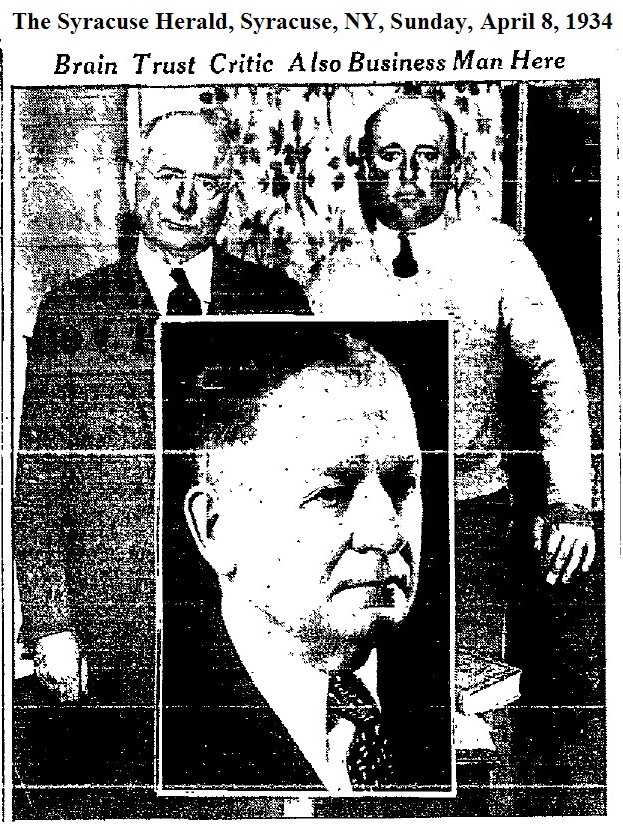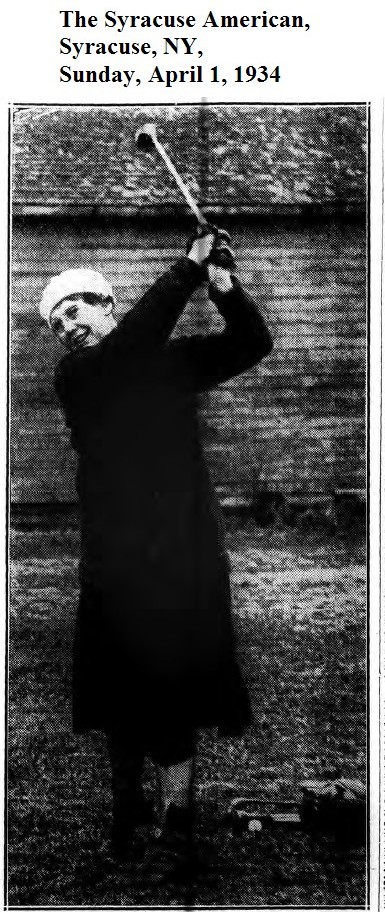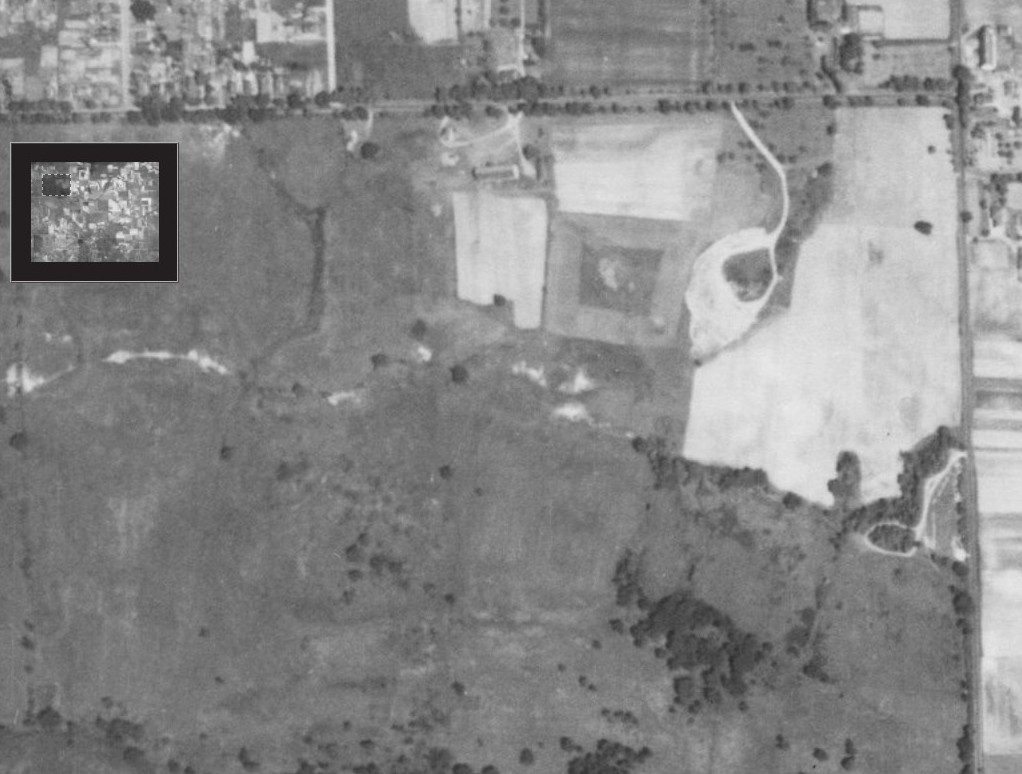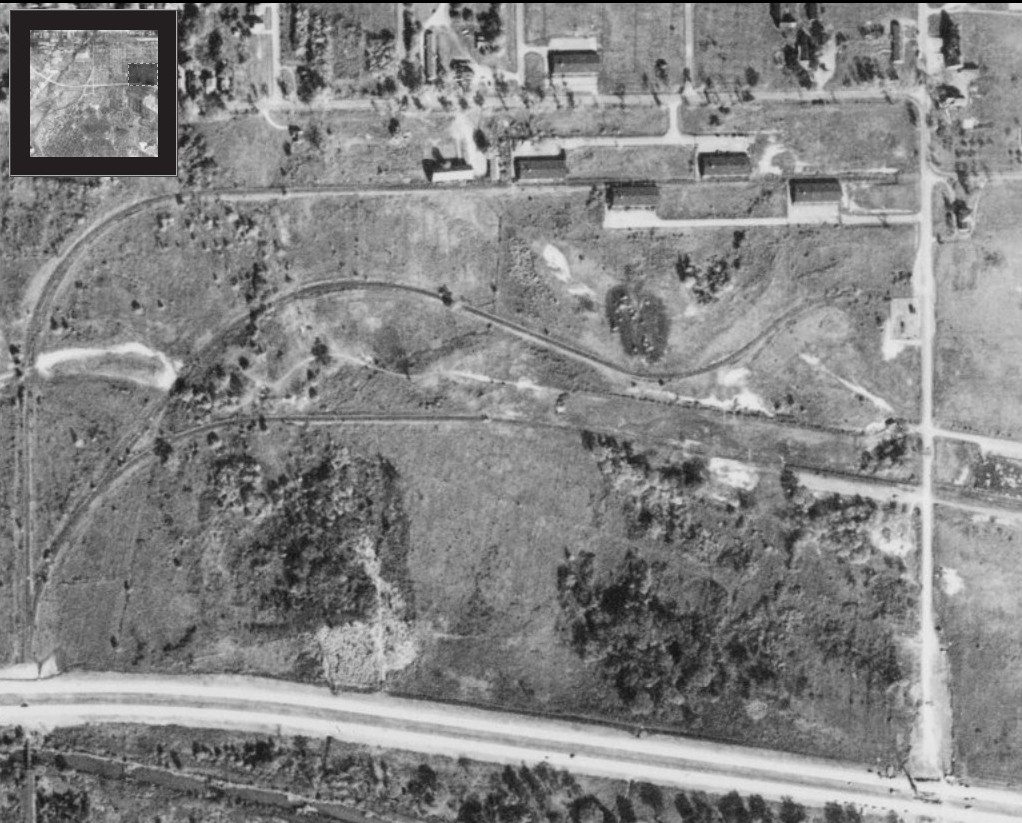
Golfmore Golf Course

Revised June 4, 2013
Chester E. Wirt started working on constructing the Golfmore Golf Course in 1926 and opened for business during the 1927 season. [0.5] The course was located on the southwest corner of E. Molloy Road and Townline Road. Wirt operated the course, with help from some family members, into the Depression but he was foreclosed on his mortgage in 1935. In 1942, the land was purchased by the U.S. Government, for the construction and operation of the U.S. Army Airbase during World War II. The property was given to the city after the war with the reservation that the Government could reclaim the land if the need arose. The Golfmore area was eventually reclaimed and has been used by the USMC Reserve since at least the 1960s.
The people involved with the property were an interesting bunch. In 1860 all the land around the Molloy Road and Townline Road intersection belonged to Patrick Malloy. When he died in 1899 the land passed to his children with James and Thomas eventually holding most of it. James owned the portion bordering Townline Road extending north and south of Molloy Road. Thomas owned a similar piece of land that was adjacent to his brother’s land on the west side. It was Thomas Malloy’s land, south of Molly Road, that became Golfmore. Thomas died on April 6, 1899 and his wife died while on vacation at Fourth Lake, in the Adirondacks, on July 31, 1899. The farm on Molloy Road went to his son Thomas.
On February 5, 1908, Thomas’ son, Thomas J. Molloy III, married Florence Cowie, the daughter of former Mayor Cowie. In 1910, Thomas Malloy III was operating an elaborate mule breeding operation on his farm. According to an article at the time [1], “The farm in itself is a model.” The article continued:
“It is owned by Mr. And Mrs. Thomas J. Molloy, who live in the old fashioned farmhouse during the summer and who take great pleasure in keeping it up. The grounds are sodded and shrubs and flowers are planted about.
“The red and canary yellow trimmings of the immaculate stables and the yellow fences are a delight to the eyes, and its modern apparatus, wind mill, black smith shop, etc., are up to date.”
By April 1912 Thomas had decided to rent his farm and held a public auction to sell off all his livestock and farm equipment. The marriage didn’t go well and his wife eventually took up with another woman. In 1918, Florence Cowie Molloy and Mabel MacLeay, along with their respective children, left for Boulder, Colorado, where they started a taxi business. In the 1920 Boulder, Colorado census, Florence listed her marital status as “D,” for Divorced. Mabel listed her marital status as “M,” for Married. From later events it appears that Florence got the Molloy Road farm in the divorce settlement.
The taxi business was a success and grew, so they added more taxis and hired extra drivers. At one point they were awarded a contract from the railroad company that gave them “the exclusive right to solicit business on the railroad property.” [1A] The male run taxi businesses had never appreciated the female competition, but now the friction got even worse. Molloy and MacLeay even received threats from the Klux Klan that caused them to consider another line of business. In 1929 the ladies got out of the taxi business and started a Dude Ranch, known as the Double M Ranch, at Gold Hills, Colorado, near Boulder. The Double M probably stood for Molloy & MacLeay. They proved to also be very successful in this business. At the time of the death of her brother, Alexander, in 1948, Florence was still living in Boulder with her daughters Mary and Jane. [1C]
Enter Chester E. Wirt on the scene. Wirt was a successful businessman from Indiana. He was in the steel business and was a partner in several banks. Chester had a wife in Indiana and a girlfriend named Jennie Smith, in Syracuse. So far, so good, but Mrs. Nellie Wirt found out about Jennie after her son found one of Jennie’s letters in her husband’s pocket. “The parting came on July 21, 1919 [B1].
Chester Wirt bought the “Thomas Molloy” farm with a mortgage sometime around September 1919. In a counter suit to his wife’s divorce filing, Alexander Cowie testified that, “he sold the Molloy Road property to Mr. Wirt and Mrs. Jennie Wirt.” The property was worth about $48,000. The fact that her brother handled the sale was an indication that Florence Cowie Molloy was the owner of the property. [2] Jennie Smith has been running the Molloy Road farm for Wirt and he was paying her.
The Wirt divorce case was finally heard in LaPorte, Indiana, in March 1921, but it was headline news in all the Syracuse papers. Wirt married Jennie Smith on Nov 5, 1921. Jennie had been in business with Wirt for ten years before their marriage. “They had been friends from youth.” [3] Jennie was the divorced wife of an Indianapolis cobbler. [2]
Chester Wirt’s brother, William, was a real piece of work. William Wirt was the Superintendent of the Gary, Indiana Public Schools. He was nationally and internationally famous for developing and implementing the “Gary Plan”, that was also known as the Platoon system. This system divided the students into two groups that participated in "work-study-play" activities and then rotated to the next activity to fully utilize the school. In September 1921 Chester and his wife Nellie sold several parcels of his Molloy Road property to his brother William [2A]. In 1934, Chester claimed that his brother William was the owner of the Golfmore property and that he (Chester) worked for his brother.
In 1934 William had attended a dinner, in McLean, VA, with several members of President Roosevelt’s “Brain Trust.” He later claimed that some of the brain trust members had told him, at that dinner, that one or more of the President’s New Deal programs were Communistic in nature. William Wirt went to the newspapers and proclaimed that there was a “Red Plot” within the Roosevelt Administration. That got him numerous headlines and an invitation to testify before a Congressional committee.
The local papers interviewed Wirt’s Syracuse relatives but they didn’t offer any opinions on the activities of their relative. William Wirt’s ownership of the Golfmore course was mentioned in the articles. This was 1934 and Golfmore went into foreclosure prior to the 1935 season. It’s uncertain as to whether the demise of Golfmore was due to bad management, the deepening of the Depression or perhaps William Wirt’s “Red Plot” notoriety.
In the 1935 foreclosure, Florence Cowie Molloy filed the foreclosure action against Chester Wirt and his wife Jennie, William Wirt and his wife, Chester’s son Lewis Wirt and another couple whose connection to the Wirt’s has not yet been determined. Her brother, Alexander Cowie’s, law firm handled the case.
Dr. William A. Wirt - Jan. 21, 1874 - Mar. 11, 1938
Chester Wirt seems to have disappeared from the Syracuse papers after 1938.
Jennie Wirt owed taxes on land in Spafford, Lot 21, Aug. 26, 1939
_________________________________
FOOTNOTES
[0.5] A Bridge Club entertained at the Golfmore Country Club on June 11, 1927.
[1] Breeding of Mules on Molloy Farm Nearby, Syracuse Journal, Syracuse, NY, April 22, 1910.
[1A] Ex-Syracuse Women Open Dude Ranch, The Syracuse Herald, Syracuse, NY, February 6, 1927.
[1C] Alexander H. Cowie Dies After 55 Years as Lawyer, Post Standard, Syracuse, NY, July 7, 1948.
[B1] Wirt’s Career Fully Told in Divorce Court, The Daily Journal, Syracuse, NY, March 10, 1921.
[2] Former Banker Declares Wife Made Him Poor, The Syracuse Herald, Syracuse, NY, December 5, 1920.
[2A] Chester Wirt Dees Lot To His Brother, Syracuse Herald, Syracuse, NY, Spetember 13, 1921.
[3] Banker Marries “Other Woman,” The Daily Journal, Syracuse, NY, December 24, 1921

|
Kin of The “Brain Trust” Critic to Syracuse: Chester E. Wirt, younger brother of Dr. William A. Wirt, superintendent of Gary, Ind. Schools, and Dr. Wirt’s son, Sherwood, shown on Golfmore Course in this city, owned by the Gary educator and managed by his brother. Dr. Wirt (in insert), who won international note with his novel educational program several years ago, recently charged that members of the ‘brain trust” intimated to him recovery (from the Great Depression) was impeded to prepare the way for Communism in the United States. |

|
Mrs. Jennie Wirt Mrs. Wirt, wife of the proprietor of the Golfmore Country Club, could not resist the temptation to get out onto the course and play a few holes on its opening day Saturday. She was one of more than 30 enthusiastic golfers who played the Golfmore course yesterday afternoon despite the driving rain. |

|
This is an aerial photo, taken on September 5, 1938, of the area where the Golfmore Course was located. East Molloy Road is running along the top of the photo and Townline Road is running north and south along the right border. The farm of the late James Malloy is located on the north side of Molloy Road about an inch west of Townline Road. The large rectangular structure just northeast of the Molloy-Townline Road intersection is the Mautz old barn. Along the east side of Townline Road the pattern of cultivated fields can be seen. All of this land was purchased by the U.S. Government in 1942 for the construction and operation of the Army Air Base. After the war some of the land was given to the city. The Malloy barn was transformed to house several families as were all the old barracks left by the Army. At the top center of the photo, on the north side of East Molloy Road, is the original Thomas Malloy that was purchased by Chester E. Wirt in 1919. Just across Molloy Road is the Golfmore Country Club. In the center of the photo, extending east and west some of the old sand traps can still be seen. Golfmore was foreclosed at the beginning of the 1935 season.
|

|
This aerial photo of the same area was taken on October 15, 1951. The late James Malloy homestead and barn near the East Molloy and Townline Road intersection are still there. The old stone homestead burned to the ground in July 1953. All the cultivated fields east of Townline Road are gone. At the time of this photo they were trying to evict all the persons in air base housing. The whole program was meant to solve a postwar housing problem and was only leased for 5 years. Into the early 1950s there were still people living in the old Malloy barn. In the area south of Molly where Golfmore was located no signs of it remain, except a few areas that might be the remnants of the old sand traps. The additional rectangular structures are buildings left by the military and many new roads have appeared. All over the base area a grid of roads was constructed. Today they have no names, although the military must have had names for them but they have not been discovered so far.
|